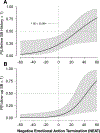Childhood Maltreatment, Emotional Response Inhibition, and Suicide in Psychiatric Inpatients
- PMID: 34656204
- PMCID: PMC8531534
- DOI: 10.1016/j.beth.2021.05.006
Childhood Maltreatment, Emotional Response Inhibition, and Suicide in Psychiatric Inpatients
Abstract
Childhood abuse and/or neglect adversely influences development of neurocognitive systems that regulate affect and behavior. Poor inhibitory control over emotional reactions is thus one potential pathway from maltreatment to suicide. Adult psychiatric inpatients completed the Childhood Trauma Questionnaire and an emotional stop-signal task indexing negative emotional action termination (NEAT): the ability to inhibit ongoing motor reactions to aversive stimuli triggered by negative affect. Clinical interviews assessed suicidal thoughts and behaviors during hospitalization (n = 131) and at follow-up assessments 6 months later (n = 87). Our primary aim was to examine whether maltreatment history and NEAT explain overlapping variance in suicidal behaviors (1) retrospectively and (2) 6 months following hospital discharge. Contrary to prediction, childhood maltreatment was unrelated to history of suicidal behaviors. However, NEAT was consistently associated with prior suicidal acts, even controlling for suicidal ideation and demographic covariates. NEAT similarly contributed to the prediction of post-discharge suicidal behaviors, whereas we found no effect of maltreatment history. The present study suggests that NEAT captures suicide risk independently of childhood maltreatment. Results implicated NEAT impairment specifically, rather than broader response inhibition deficits (e.g., to positive stimuli), in past and future suicidal behaviors. These findings provide preliminary support for NEAT as a behavioral vulnerability marker for suicide, with implications for understanding links between maltreatment history and suicidal acts.
Keywords: child abuse; cognitive control; emotion dysregulation; suicide; trauma.
Copyright © 2021. Published by Elsevier Ltd.
Conflict of interest statement
Conflict of Interest Statement The authors declare no conflicts of interest.
Figures

Similar articles
-
Childhood maltreatment severity and suicidal ideation among adults receiving acute-care psychiatric inpatient services: The role of distress tolerance.Psychol Trauma. 2021 Mar;13(3):333-337. doi: 10.1037/tra0000663. Epub 2020 Aug 27. Psychol Trauma. 2021. PMID: 32853013
-
The effects of childhood emotional maltreatment and alexithymia on depressive and manic symptoms and suicidal ideation in females with bipolar disorder: emotion dysregulation as a mediator.Int J Psychiatry Clin Pract. 2021 Mar;25(1):90-102. doi: 10.1080/13651501.2021.1879867. Epub 2021 Feb 9. Int J Psychiatry Clin Pract. 2021. PMID: 33559512
-
The relations between childhood maltreatment, shame, guilt, depression and suicidal ideation in inpatient adolescents.J Affect Disord. 2020 Nov 1;276:667-677. doi: 10.1016/j.jad.2020.07.056. Epub 2020 Jul 18. J Affect Disord. 2020. PMID: 32871699
-
Childhood-maltreatment subtypes in bipolar patients with suicidal behavior: systematic review and meta-analysis.Braz J Psychiatry. 2020 Sep-Oct;42(5):558-567. doi: 10.1590/1516-4446-2019-0592. Braz J Psychiatry. 2020. PMID: 32520164 Free PMC article.
-
[Childhood Maltreatment and Non-Suicidal Self-Injury - the Impact of Emotion Regulation].Prax Kinderpsychol Kinderpsychiatr. 2019 Nov;68(7):623-638. doi: 10.13109/prkk.2019.68.7.623. Prax Kinderpsychol Kinderpsychiatr. 2019. PMID: 31711398 Review. German.
Cited by
-
Electrophysiological Changes Between Patients With Suicidal Ideation and Suicide Attempts: An Event-Related Potential Study.Front Psychiatry. 2022 May 20;13:900724. doi: 10.3389/fpsyt.2022.900724. eCollection 2022. Front Psychiatry. 2022. PMID: 35669267 Free PMC article.
-
Risk of Suicidal Behavior in Children and Adolescents Exposed to Maltreatment: The Mediating Role of Borderline Personality Traits and Recent Stressful Life Events.J Clin Med. 2021 Nov 14;10(22):5293. doi: 10.3390/jcm10225293. J Clin Med. 2021. PMID: 34830576 Free PMC article.
-
Clinical and electrophysiological correlates of hopelessness in the context of suicide risk✰.Eur Neuropsychopharmacol. 2024 Mar;80:38-45. doi: 10.1016/j.euroneuro.2023.12.002. Epub 2024 Feb 3. Eur Neuropsychopharmacol. 2024. PMID: 38310748 Free PMC article.
-
Cognitive Training for Emotion-Related Impulsivity and Rumination: Protocol for a Pilot Randomized Waitlist-Controlled Trial.JMIR Res Protoc. 2025 Feb 19;14:e54221. doi: 10.2196/54221. JMIR Res Protoc. 2025. PMID: 39970439 Free PMC article.
-
Validation of an emotional stop-signal task to probe individual differences in emotional response inhibition: Relationships with positive and negative urgency.Brain Neurosci Adv. 2021 Nov 18;5:23982128211058269. doi: 10.1177/23982128211058269. eCollection 2021 Jan-Dec. Brain Neurosci Adv. 2021. PMID: 34841088 Free PMC article.
References
-
- Allen KJD, Bozzay ML, & Edenbaum ER (2019). Neurocognition and suicide risk in adults. Current Behavioral Neuroscience Reports, 6(4), 151–165. 10.1007/s40473-019-00189-y - DOI
Publication types
MeSH terms
Grants and funding
LinkOut - more resources
Full Text Sources
Medical
Miscellaneous

